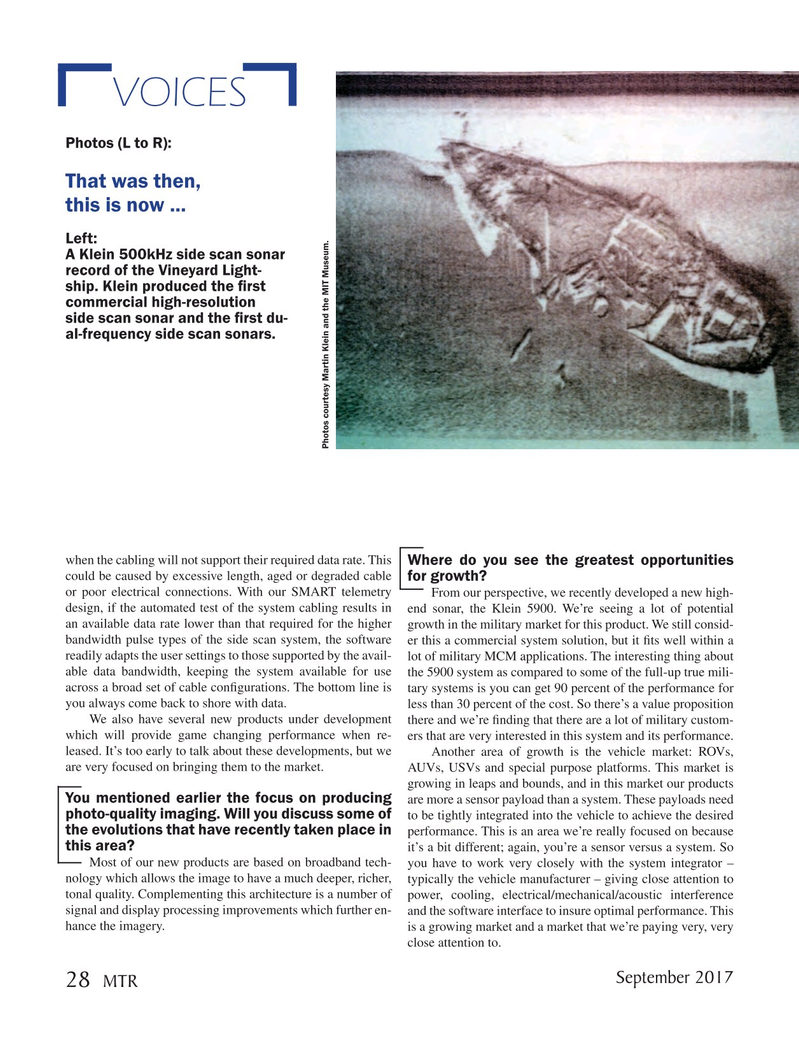
Page 28: of Marine Technology Magazine (September 2017)
Ocean Observation: Gliders, Buoys & Sub-Surface Networks
Read this page in Pdf, Flash or Html5 edition of September 2017 Marine Technology Magazine
VOICES
Photos (L to R):
That was then, this is now ...
Left:
A Klein 500kHz side scan sonar record of the Vineyard Light- ship. Klein produced the ? rst commercial high-resolution side scan sonar and the ? rst du- al-frequency side scan sonars.
Photos courtesy Martin Klein and the MIT Museum.
when the cabling will not support their required data rate. This
Where do you see the greatest opportunities could be caused by excessive length, aged or degraded cable for growth?
or poor electrical connections. With our SMART telemetry From our perspective, we recently developed a new high- design, if the automated test of the system cabling results in end sonar, the Klein 5900. We’re seeing a lot of potential an available data rate lower than that required for the higher growth in the military market for this product. We still consid- bandwidth pulse types of the side scan system, the software er this a commercial system solution, but it ? ts well within a readily adapts the user settings to those supported by the avail- lot of military MCM applications. The interesting thing about able data bandwidth, keeping the system available for use the 5900 system as compared to some of the full-up true mili- across a broad set of cable con? gurations. The bottom line is tary systems is you can get 90 percent of the performance for you always come back to shore with data. less than 30 percent of the cost. So there’s a value proposition We also have several new products under development there and we’re ? nding that there are a lot of military custom- which will provide game changing performance when re- ers that are very interested in this system and its performance. leased. It’s too early to talk about these developments, but we Another area of growth is the vehicle market: ROVs, are very focused on bringing them to the market. AUVs, USVs and special purpose platforms. This market is growing in leaps and bounds, and in this market our products
You mentioned earlier the focus on producing are more a sensor payload than a system. These payloads need photo-quality imaging. Will you discuss some of to be tightly integrated into the vehicle to achieve the desired the evolutions that have recently taken place in performance. This is an area we’re really focused on because this area?
it’s a bit different; again, you’re a sensor versus a system. So Most of our new products are based on broadband tech- you have to work very closely with the system integrator – nology which allows the image to have a much deeper, richer, typically the vehicle manufacturer – giving close attention to tonal quality. Complementing this architecture is a number of power, cooling, electrical/mechanical/acoustic interference signal and display processing improvements which further en- and the software interface to insure optimal performance. This hance the imagery. is a growing market and a market that we’re paying very, very close attention to.
September 2017 28 MTR
MTR #7 (18-33).indd 28 MTR #7 (18-33).indd 28 8/22/2017 11:17:45 AM8/22/2017 11:17:45 AM

 27
27

 29
29
